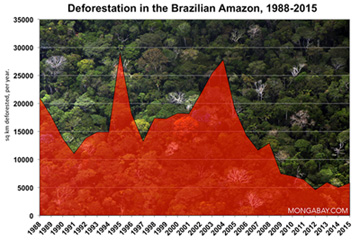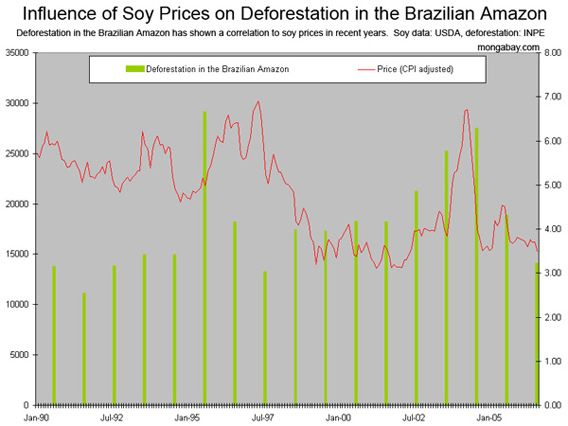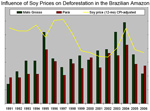Amazon deforestation rates drop 20% in 2007
Amazon deforestation rates drop 20% in 2007
mongabay.com
December 8, 2007
Deforestation rates in Brazil’s Amazon rainforest dropped 20 percent since last year, reported the Brazilian National Institute of Space Research (INPE).
The preliminary figures — based on the government’s PRODES-satellite tracking system for deforestation in the region and revised upward from estimates released in August — show that between August 2006 and July 2007, 11,224 square kilometers of forest were cleared, down from 14,040 square kilometers during the prior year period. Final figures will be released next year.

|
Deforestation rates have dropped sharply in Brazil since peaking at 27,429 square kilometers in 2004. While the Brazilian government credits increased enforcement and the establishment of massive forest reserves for slowing deforestation rates, analysts say commodity prices and currency fluctuations are important drivers of forest clearing. As soy prices have spiked in recent months, there are signs that deforestation is again on the upswing. Data from Brazil’s Real Time Deforestation Monitoring System (DETER) system suggests that forest clearing has increased most in the states of Para and Mato Grosso where most of the region’s soy and cattle are produced. By some measures, the number of fires in the Amazon approached stood near record levels this past summer.


The new figures show that the states of Para (5,569 sq km), Mato Grosso (2,476 sq km) and Rondonia (1,465 sq km) together accounted for 85 percent of deforestation in the Amazon in the period 2006-2007.
The latest numbers have been refined from earlier estimates. This past August, INPE said that 3,707 square miles (9,600 square kilometers) of rainforest were cleared between August 1, 2006 and July 30, 2007. The newly released figures are about 17 percent higher.
Related articles
Global warming accelerates destruction of the Amazon
(12/6/2007) Deforestation and climate change could damage or destroy as much as 60 percent of the Amazon rainforest by 2030, according to a new report from environmental group WWF. The report, The Amazon’s Vicious Cycles: Drought and Fire in the Greenhouse, shows that degradation in the Amazon could release 55-97 million tons of carbon dioxide by 2030. Forest loss could also dramatically impact water cycles in the region, affecting rainfall that is critical for river flows and agriculture.
Amazon deforestation could be eliminated with carbon priced at $3
(12/4/2007) The Amazon rainforest could play a major part in reducing greenhouse gas emissions that result from deforestation, reports a new study published by scientists at the Woods Hole Research Center, the Instituto de Pesquisa Ambiental da Amazônia, and the Universidade Federal de Minas Gerais. At a carbon price of $3 per ton, protecting the Amazon for its carbon value could outweigh the opportunity costs of forgoing logging, cattle ranching, and soy expansion in the region. 2008 certified emission-reduction credits for carbon currently trade at more than $90 per ton ($25 per ton of CO2).
Could the carbon market save the Amazon rainforest?
(11/29/2007) The global carbon market could play a key role in saving the Amazon from the effects of climate change and economic development, which could otherwise trigger dramatic ecological changes, reports a new paper published in Science. The authors argue that a well-articulated plan, financed by carbon markets, could prevent the worst outcomes for the Amazon forest while generating economic benefits for the region’s inhabitants.
 |
Subtle threats could ruin the Amazon rainforest
(11/7/2007) While the mention of Amazon destruction usually conjures up images of vast stretches of felled and burned rainforest trees, cattle ranches, and vast soybean farms, some of the biggest threats to the Amazon rainforest are barely perceptible from above. Selective logging — which opens up the forest canopy and allows winds and sunlight to dry leaf litter on the forest floor — and 6-inch high “surface” fires are turning parts of the Amazon into a tinderbox, putting the world’s largest rainforest at risk of ever-more severe forest fires. At the same time, market-driven hunting is impoverishing some areas of seed dispersers and predators, making it more difficult for forests to recover. Climate change — an its forecast impacts on the Amazon basin — further looms large over the horizon.
 |
2007 Amazon fires among worst ever
(10/22/2007) By some measures, forest fires in the Amazon are at near-record levels, according to analysis Brazilian satellite data by mongabay.com. A surge in soy and cattle prices may be contributing to an increase in deforestation since last year. Last year environmentalists and the Brazilian government heralded a sharp fall in deforestation rates, the third consecutive annual decline after a peak in 2004. Forest loss in the 2006-2007 season was the lowest since record-keeping began in the late in 1970s. While the government tried to claim credit for the drop, analysts at the time said that commodity prices were a more likely driver of slow down: both cattle and soy prices had declined significantly over the previous months.
Is the Amazon more valuable for carbon offsets than cattle or soy?
(10/17/2007) After a steep drop in deforestation rates since 2004, widespread fires in the Brazilian Amazon (September and October 2007) suggest that forest clearing may increase this year. All told, since 2000 Brazil has lost more than 60,000 square miles (150,000 square kilometers) of rainforest — an area larger than the state of Georgia or the country of Bangladesh. Most of this destruction has been driven by clearing for cattle pasture and agriculture, often in association with infrastructure development and improvements. Higher commodity prices, especially for beef and soy, have further spurred forest conversion in the region. While drivers of Amazon deforestation are stronger than ever, mounting concerns over climate change and the effort to reign in greenhouse gas emissions may provide new economic incentives for landowners to preserve forest lands through a concept known as “avoided deforestation”.
Amazon deforestation in Brazil falls 29% for 2007
(8/13/2007) Deforestation in the Brazilian Amazon fell 29 percent for the 2006-2007 year, compared with the prior period. The loss of 3,863 square miles (10,010 square kilometers) of rainforest was the lowest since the Brazilian government started tracking deforestation on a yearly basis in 1988.














